Workshop for Teachers Emphasizes Creative Side of STEM
Published 12.15.2015
Learning looked a lot like play when more than 90 middle school educators from across Pennsylvania – and a few from other states – convened at Pennsylvania College of Technology to sit on the learning end of hands-on lessons that they can take back to school to help engage their students in science, technology, engineering and math topics.
According to a 2012 report by the President’s Council of Advisors on Science & Technology, economic projections point to a need for approximately 1 million more STEM professionals than the U.S. will produce at the current rate over the next decade if the country is to retain its historical pre-eminence in science and technology.
“If we are truly preparing students at both the secondary and postsecondary levels, we are preparing them for 21st-century jobs,” said Paul R. Watson, Penn College’s dean of academic services and college transitions. “Twenty-first century jobs primarily focus on STEM.”
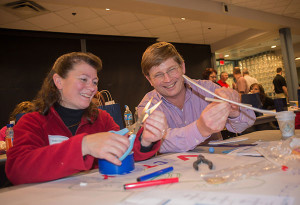 The college and BLaST Intermediate Unit 17 worked together to host the one-day event, which introduced the teachers to the National Integrated Cyber Education Research Center’s “STEM: Explore, Discover, Apply” curriculum.
The college and BLaST Intermediate Unit 17 worked together to host the one-day event, which introduced the teachers to the National Integrated Cyber Education Research Center’s “STEM: Explore, Discover, Apply” curriculum.
Subject-matter experts and curriculum developers from NICERC walked educators through fun sample lessons in the free curriculum, which gets students practicing engineering design principles, or creative problem-solving. The lessons use hands-on experiments and liberal-arts disciplines to provide meaning and depth to the content.
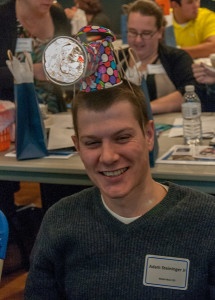 In a sample the teachers practiced, a lesson on electrical circuits was enhanced by building flashlights of their own design and making up a story about using the lights in the face of a cyberattack that shut down the nation’s electrical grid.
In a sample the teachers practiced, a lesson on electrical circuits was enhanced by building flashlights of their own design and making up a story about using the lights in the face of a cyberattack that shut down the nation’s electrical grid.
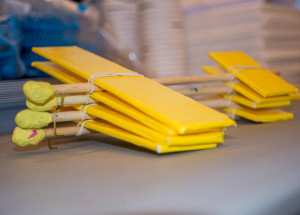 The afternoon’s aerodynamics lesson had teachers building and testing rubber band-powered gliders while learning about the gliders of World War II and the propaganda that surrounded the war. The lesson paired creativity with students’ newfound knowledge not only to devise the shape, size, color and position of their gliders’ wings and nose cones, but to develop glider-related propaganda posters.
The afternoon’s aerodynamics lesson had teachers building and testing rubber band-powered gliders while learning about the gliders of World War II and the propaganda that surrounded the war. The lesson paired creativity with students’ newfound knowledge not only to devise the shape, size, color and position of their gliders’ wings and nose cones, but to develop glider-related propaganda posters.
“Incorporating writing and history helps kids eliminate the boundaries between subjects,” said John Ownby, a curriculum development specialist for NICERC. “So they’re not thinking ‘I only do math in math class, and I only write in English class.’ It helps them see their studies are like life. And it helps them use math and science to see things that they see every day in a new way.”
“We drove two hours to get here, and already it’s worth it,” said Dianne Haberstroh, a seventh-grade science teacher in the Parkland School District in Allentown, about two hours into the daylong event.
Haberstroh and her Parkland colleagues used paper cups, duct tape and other simple materials to design a torch-style light, while other groups built wearable headlamps, added pockets to store extra batteries and – in the case of Williamsport Area Middle School teachers – made an imaginative Swiss army-style multifunction light. Groups also built the circuits that powered their lights, choosing a parallel or series circuit.
“It’s applying all the concepts they’ve learned in class in a creative way,” said Daniel Christman, also a middle school science teacher at Parkland.
Giving students the freedom to choose what their flashlights will look like and how they will function is important to keeping them interested, he said.
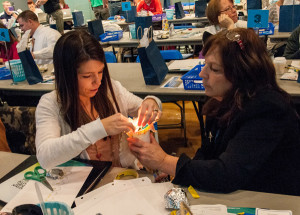 “The student choice is key,” he said. “You give them a box of stuff and tell them to go to it.”
“The student choice is key,” he said. “You give them a box of stuff and tell them to go to it.”
The critical thinking practiced in the lessons is also vital, Haberstroh said. “It’s creative problem-solving, and that’s what engineers have to do.”
In addition, the hands-on group activities help students to develop skills in leadership, team-building and communication.
Christina Steinbacher-Reed, coordinator for professional learning and curriculum development for the local Intermediate Unit, explained the partnership that brought Penn College, the BLaST Intermediate Unit and NICERC together.
“BLaST represents 19 school districts in four counties,” she said. Those counties are Bradford, Lycoming, Sullivan and Tioga. “Our districts need support with STEM, so we started partnering with the college, looking at how we can improve STEM education.”
The college, a national leader in applied technology education, got in touch with NICERC and provided the facility, and the Intermediate Unit brought school districts together.
“It went farther than we expected,” Steinbacher-Reed said of the schools represented at the event. “That is very rare for our area, since geographically, we’re isolated.”
NICERC was pleased with the turnout, as well. It was the center’s first workshop in Pennsylvania and boasted the second-largest attendance for the center thus far.
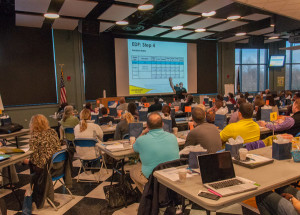 The National Integrated Cyber Education Research Center is an academic division of the Cyber Innovation Center, which was identified by the Department of Homeland Security as the national model for cyber education. The center’s team of subject-matter experts and master teachers travels to communities across the nation to host STEM EDA workshops for middle school teachers.
The National Integrated Cyber Education Research Center is an academic division of the Cyber Innovation Center, which was identified by the Department of Homeland Security as the national model for cyber education. The center’s team of subject-matter experts and master teachers travels to communities across the nation to host STEM EDA workshops for middle school teachers.
“By educating teachers, we are impacting hundreds and hundreds of students to understand STEM education, STEM careers and what it means to be part of that workforce,” said Chuck Gardner, subject matter expert for NICERC.
“Here’s an opportunity for educators to continuously hone their craft in providing meaningful and relevant explorations in STEM subjects, and that, in my opinion, is what it’s all about,” Penn College’s Watson said.
The College Transitions Office at Penn College provides services, activities and resources to teachers, counselors, administrators and students in K-12 schools. To learn more, email or call 570-320-8003.
For information about Penn College, email the Admissions Office or call toll-free 800-367-9222.